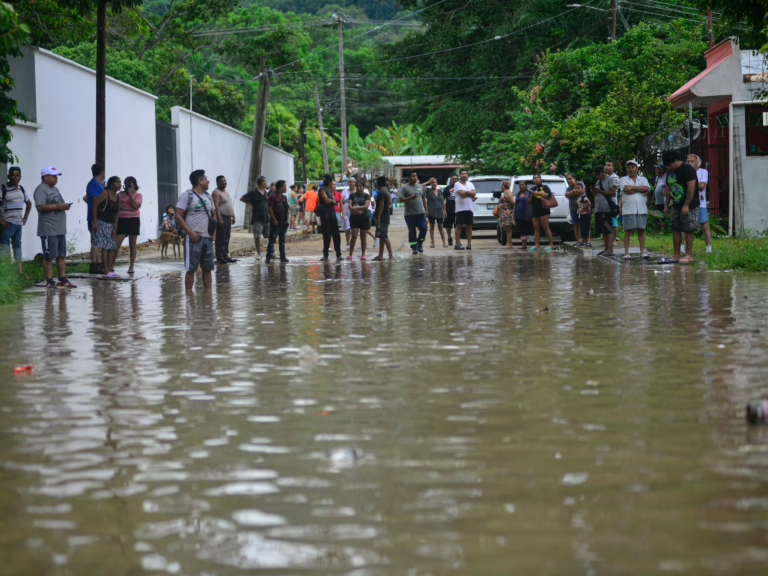Severe flooding triggered by intense rainfall across Mexico has resulted in at least 28 fatalities, numerous missing persons, and widespread destruction including landslides, damaged residences, and compromised roadways, local officials report.
Persistent heavy rains in central and southeastern regions caused rivers to overflow and roads to collapse, leading to power outages in several municipalities, according to Laura Velazquez, the national civil defense coordinator, on Friday.
Authorities noted that 31 out of 32 states experienced significant rainfall, with Veracruz on the Gulf coast, Queretaro and Hidalgo in the central zone, and San Luis Potosi in the north-central area suffering the most severe impacts.
Hidalgo, one of the hardest-hit states, has reported 16 deaths, as confirmed by Interior Secretary Guillermo Olivares Reyna. The state has seen extensive damage, with over 1,000 homes, 59 healthcare facilities, and 308 schools affected by flooding and landslides.
In the neighboring state of Puebla, nine lives were lost and 13 individuals remain unaccounted for. The governor stated that approximately 80,000 residents were impacted by the storms, and a landslide caused a rupture in a gas pipeline.
Veracruz’s governor reported two fatalities, including a police officer, with around 5,000 homes damaged. The navy has evacuated nearly 900 people to emergency shelters in the area.
Earlier reports from Queretaro confirmed the death of a child caught in a landslide, underscoring the widespread danger posed by the torrential rains.
Power disruptions have affected over 320,000 users, and nearly 1,000 kilometers (621 miles) of roads across six states have sustained damage, officials revealed.
Tras las fuertes lluvias, la Secretaría de Marina (@SEMAR_mx) desplegó tres mil 300 elementos en Puebla, Veracruz y San Luis Potosí. También puso a disposición 18 embarcaciones, seis helicópteros, tres plantas potabilizadoras, tres aviones, tres cocinetas y cuatro mil… pic.twitter.com/O7ES5XBoKC
– Claudia Sheinbaum Pardo (@Claudiashein) October 11, 2025
Translation: In response to the heavy rains, the Navy Department (@SEMAR_mx) deployed 3,300 personnel across Puebla, Veracruz, and San Luis Potosí. They also provided 18 boats, six helicopters, three water purification units, three aircraft, three mobile kitchens, and 4,000 food packages ready for distribution.
President Claudia Sheinbaum emphasized ongoing efforts to assist affected communities, clear blocked roads, and restore electricity following a coordination meeting with regional leaders and cabinet members. She shared images of emergency teams delivering aid while navigating flooded streets.
More than 8,700 military personnel have been mobilized nationwide to support evacuation, monitoring, and recovery operations in the hardest-hit zones.
Throughout 2025, Mexico has experienced unusually heavy rainfall, with Mexico City setting new precipitation records.
Currently, Tropical Storm Raymond is advancing along the Pacific coast, bringing additional heavy rains as it moves northward. Forecasts predict it will make landfall on Mexican soil by Sunday. Raymond was identified by the U.S. National Hurricane Center on Thursday afternoon, marking the third tropical system this week near Mexico’s western coastline, alongside Tropical Storm Priscilla and the post-tropical cyclone Octave, both of which posed flooding threats.
Massive waves battered Mexico’s Pacific shoreline as Hurricane Priscilla caused flooding along Puerto Vallarta’s waterfront. pic.twitter.com/P3s5lsiz9r
– AccuWeather (@accuweather) October 10, 2025
Meteorologists have issued warnings about the resurgence of La Niña, a Pacific Ocean cooling phenomenon known to disrupt global weather patterns and intensify hurricane activity.
Although it may be too late in the Atlantic hurricane season to significantly influence tropical storms there, this La Niña event could still trigger extreme weather variations worldwide, ranging from severe droughts to heavy precipitation.






















